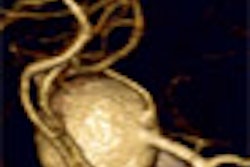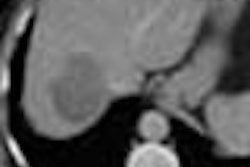
AuntMinnie.com is pleased to present Part II of our three-part series, Turf Wars in Radiology.
Interventional radiologists and their pulmonary colleagues are sharing the workload when it comes to treating many lung pathologies. Their secret is knowing when to let the other specialty step in -- a cross between old-fashioned teamwork and doing whatever’s best for the patient.
First, here’s the would-be dilemma: In the past decade, pulmonologists have amassed a broad range of minimally invasive techniques, thanks to leapfrogging advances in thoracic endoscopy, laser treatment, stents, and electrocautery probes. According to a New England Journal of Medicine article, interventional pulmonologists perform pulmonary angiographies, arteriovenous malformation embolizations, bronchial artery embolizations, lung biopsies, bronchial stenting, and pleural drainages (NEJM, March 8, 2001, Vol: 344:10, pp. 740-749).
And in the future, pulmonologists may offer an alternative to surgery for the treatment of early-stage lung cancer and benign endobronchial tumors, the article concluded.
Unfortunately, interventional thoracic radiologists have been plying many of these same procedures for years, which could produce the last thing radiology needs: another turf battle. But unlike the high-profile battle of wills over emergency radiology and cardiac imaging, it’s mostly quiet on the thoracic interventional front. Instead of hoarding turf, some of the nation’s leading lung specialists are developing a team-based approach to interventional pulmonary medicine.
All for one and one for all
"Although some people have a tendency to hog procedures, that’s certainly not my vision," said Dr. Henri Colt, chief of interventional pulmonology at the University of California, San Diego. "Instead, we enjoy the consultative component, which means determining who among the many different specialties is best equipped to handle a particular patient."
At UCSD, it means that interventional pulmonologists, interventional radiologists, and thoracic surgeons all get a crack at providing care to patients with advanced lung disorders. And now that PET imaging and high-resolution CT are forging new ground in lung cancer imaging, even diagnostic radiologists are included in interventional care decisions, Colt said.
For example, a solitary pulmonary nodule can be either a suspected primary lung cancer or a metastatic nodule from another cancer. In some cases, a series of CT and PET scans performed by a diagnostic radiologist is all that’s needed to classify the nodule. But if a biopsy is required, the case is then sent to either an interventional pulmonologist or radiologist.
Another example is a patient with a pleural effusion that requires draining. Depending on where in the pleural space the fluid is located, as well as the patient’s condition, the procedure may be conducted by the referring primary care doctor, the pulmonologist, or the oncologist, Colt said. But in some cases, such as when only a small volume of fluid is present, an interventional radiologist may use ultrasound guidance to ensure the safety of the procedure.
Turf scuffles, not battles
That’s not to say that turf flare-ups don’t occur. It’s just that they tend to be small, low-key affairs.
"If pulmonologists were more like cardiologists, we’d have a problem," said Dr. Ella Kazerooni, director of the thoracic radiology division at the University of Michigan in Ann Arbor. "But they’re busy with their own work, and they’re not very aggressive."
For example, a pulmonary nodule can be biopsied several ways, Kazerooni explained. If the nodule is large and located near a central airway, an interventional pulmonologist can do the job using bronchoscopy. If it’s a peripheral, small nodule, however, CT guidance is usually required and a radiologist gets the nod. But if the nodule is not too big or too small, or located somewhere between a peripheral and central airway, it’s fair game for both camps, Kazerooni said.
"And some bronchoscopists go after small, peripheral nodules that I think are best biopsied with CT guidance," she said.
In the future, such minor squabbles may be refereed by multidisciplinary interventional pulmonary programs. As Colt said, his UCSD program serves as a gatekeeper, ensuring that patients are routed to the specialist who’s best qualified to treat them. He also believes patients aren’t the only beneficiaries when it comes to team-based pulmonary care.
"I believe that without the multidisciplinary approach, the interventional radiologist is simply a technician, rather than a full-fledged member of a healthcare team," Colt said.
If this is true, future interventional thoracic radiologists may find safe harbor at one of several team-based lung centers. Beth Israel Deaconess Medical Center’s Interventional Pulmonary Center in Boston employs a team of pulmonologists, thoracic surgeons, and chest radiologists -- to name just a few specialists -- to evaluate and treat airway obstructions.
Another team approach has been adopted by a group of physicians at Walter Reed Army Medical Center in Washington, DC. They’ve formed a multidisciplinary airway stent team that consists of interventional radiologists, otolaryngologists, and pulmonologists. According to the team’s protocol, which was published in the Annals of Otology, Rhinology, and Laryngology, patients with suspected airway obstruction are first examined with both a CT scan and a videotaped flexible bronchoscopy.
The team then reviews these studies, and together they devise the best treatment strategy. In those cases in which tracheobronchial stent placement is required, a mix of imaging modalities, such as rigid and flexible bronchoscopy, as well as fluoroscopy, are used to guide the procedure (Annals of Otology, Rhinology, and Laryngology, October 2000, Vol.109:10, Part 1, pp. 889-898).
Protocols like these offer an alternative to the deeply entrenched tendency to guard procedures.
"The big problem is that medicine is structured by specialty," Colt said. "You get into an 'I need to protect my turf' mentality, which in the long run is not optimal for patient care."
By Dan KrotzAuntMinnie.com contributing writer
August 17, 2001
Related Reading
Turf wars in radiology, Part I: Rads, attendings duke it out in the ER, August 10, 2001
Next installment: Who will reign supreme in nuclear cardiology?
Copyright © 2001 AuntMinnie.com



















